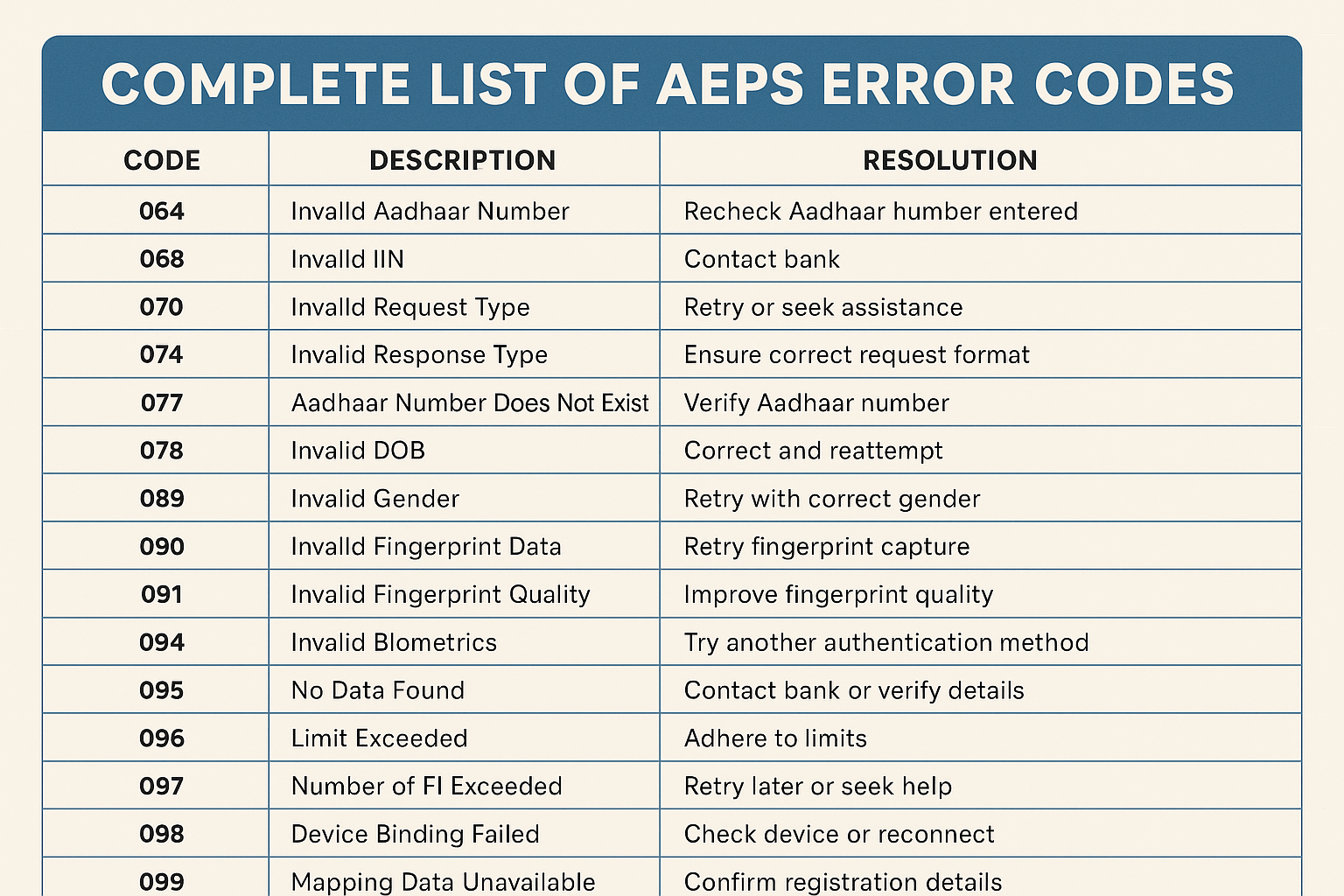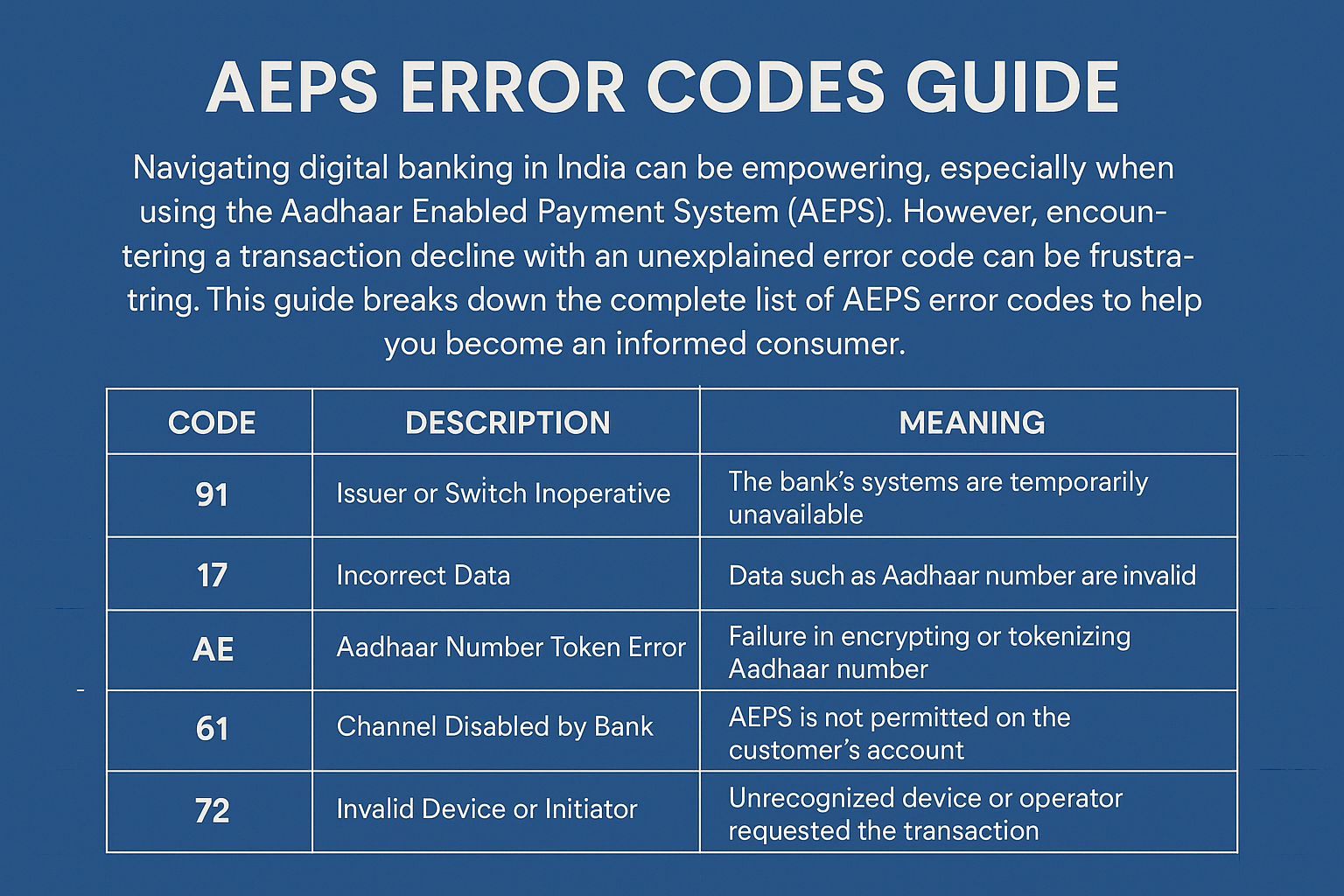Navigating the world of digital banking in India, especially (AEPS Error Codes) through the Aadhaar-enabled Payment System (AEPS), can be incredibly empowering. However, a sudden transaction decline accompanied by a cryptic AEPS error code can be frustrating and confusing. This comprehensive guide is your definitive resource for understanding what these codes mean, why they occur, and how to resolve them. We will demystify the complete list of AEPS error codes, transforming you from a perplexed user into an informed consumer.
What is AEPS and Why Do Error Codes Occur?
Before we dive into the codes themselves, it’s crucial to understand the ecosystem. AEPS is a bank-led model that allows online interoperable financial transactions at PoS (Point of Sale / MicroATM) through the Business Correspondent (BC) using Aadhaar authentication. It’s a complex network involving your bank, the NPCI (National Payments Corporation of India), UIDAI (Unique Identification Authority of India), and the service provider.
An AEPS error code is a standardized message from this network indicating that a particular step in the transaction process has failed. These codes are essential for BCs and customers alike to quickly diagnose and address the problem without revealing sensitive system information.
Common reasons for these errors include:
-
Network Issues: Connectivity problems between the BC’s device, the bank’s server, or NPCI.
-
Input Errors: Incorrect Aadhaar number, IIN (Bank Identifier), or fingerprint data.
-
Account Issues: Insufficient balance, invalid account type, or a frozen account.
-
Aadhaar-Related Problems: Biometric not locked/updated, or Aadhaar number not mapped to the bank account.
-
Technical Glitches: Temporary downtime of bank servers or NPCI systems.

The Complete List of Common AEPS Error Codes and Their Meanings
Here is a detailed breakdown of the most frequently encountered AEPS error codes, categorized for easier understanding.
Category 1: Transaction Success Codes
These are the codes you want to see. They indicate a successful transaction.
-
00orZ0: Transaction Approved / Success-
Meaning: The transaction was completed successfully. The funds have been debited or credited as requested.
-
Action: No action needed. Collect your cash or receipt.
-
Category 2: Customer Input & Data Issues
These errors are often due to mistakes in the information provided.
-
100orZG: Invalid Aadhaar Number-
Meaning: The Aadhaar number entered is not valid (wrong number of digits, incorrect checksum, or not issued by UIDAI).
-
Action: Re-enter the Aadhaar number carefully. The customer should verify their Aadhaar number.
-
-
101orZL: Invalid IIN (Bank Identifier)-
Meaning: The first 4 or 6 digits entered to identify the bank are incorrect.
-
Action: The BC must select the correct bank name from the list or enter the right IIN code.
-
-
102orZM: Invalid Transaction Type-
Meaning: The type of transaction selected (e.g., Cash Withdrawal, Balance Inquiry) is not recognized or supported.
-
Action: This is typically a terminal/device error. The BC should restart the transaction.
-
-
103orZN: Aadhaar Number Not Mapped / Seeded-
Meaning: This is one of the most common errors. The customer’s Aadhaar number is not linked to their bank account.
-
Action: The customer must visit their bank branch and ensure their Aadhaar is successfully seeded (linked) to their account.
-
-
104: Invalid Transaction Amount-
Meaning: The amount entered is invalid (e.g., below the minimum or above the maximum limit, or contains decimals where not allowed).
-
Action: Enter a valid amount within the permissible limits.
-
Category 3: Biometric Authentication Failures
These errors originate from the UIDAI system during fingerprint or iris authentication.
-
201orB1: Invalid Biometric Data-
Meaning: The fingerprint or iris scan was unreadable or of very poor quality.
-
Action: Clean the fingerprint scanner and ask the customer to ensure their finger is clean and dry. Try again.
-
-
202orB2: Biometric Mismatch-
Meaning: The captured biometric data does not match the data stored in the UIDAI database.
-
Action: Try a different finger. If it persists, the customer may need to update their biometrics at an Aadhaar enrolment centre.
-
-
203orB3: Biometric Locked-
Meaning: The customer has voluntarily locked their Aadhaar biometrics for security via the UIDAI website/mAadhaar app.
-
Action: The customer must unlock their biometrics through the same channel before attempting an AEPS transaction.
-
Category 4: Bank & Account Related Issues
These errors are generated by the customer’s bank after the authentication is successful.
-
501: Insufficient Balance-
Meaning: The customer’s account does not have enough funds to complete the cash withdrawal transaction.
-
Action: The customer should check their balance first or add funds to their account.
-
-
502orU6: Invalid Account Type / Transaction Not Permitted-
Meaning: The linked bank account might be a loan account, dormant account, or a type that does not permit AEPS transactions.
-
Action: The customer should contact their bank to confirm if their account is eligible for AEPS.
-
-
503: Account Blocked / Frozen-
Meaning: The bank has placed a block or freeze on the account due to suspicious activity, KYC non-compliance, or other reasons.
-
Action: The customer must immediately contact their bank branch to resolve the issue.
-
Category 5: Technical & System Failures
These are system-level errors often beyond the control of the customer or BC.
-
901: NPCI / Switch Down-
Meaning: The National Payments Corporation of India’s system is temporarily unavailable.
-
Action: Wait for some time and try the transaction again later.
-
-
902: Destination Bank / Host Down-
Meaning: The customer’s bank server (host) is not responding or is under maintenance.
-
Action: The transaction cannot be processed until the bank’s systems are back online. Try after some time.
-
-
909: Timeout / Transaction Timed Out-
Meaning: The system did not receive a response from the bank or NPCI within the expected time frame, often due to a network lag.
-
Action: This error does not always mean the transaction failed. Always check the balance before retrying to avoid duplicate debits. Retry the transaction.
-
-
910: Duplicate Transaction-
Meaning: A transaction with the same details was processed very recently. This is a safety feature to prevent duplicate debits.
-
Action: If the previous transaction failed with a timeout, wait for 15-30 minutes for the system to reconcile before trying again.
-

What to Do When You Encounter an AEPS Error Code?
-
Don’t Panic: The error code is a message, not a permanent block.
-
Inform the Customer: Read out the error code and its simple meaning (e.g., “It says insufficient balance, could you please check?”).
-
Verify Inputs: Double-check the Aadhaar number, bank selection, and amount.
-
Retry with Care: For biometric errors, clean the scanner and try a different finger. For technical timeouts (
909), always check the balance first. -
Escalate if Needed: If the error persists (especially
103– Aadhaar not mapped or503– Account blocked), advise the customer to visit their bank branch for a resolution.
The Future of AEPS and Error Handling
The NPCI and banks are continuously working to make the AEPS network more robust. Error messages are becoming more descriptive for BCs. Furthermore, the rise of Aadhaar-based ATM transactions makes understanding these codes even more critical for the general public. Reliable sources like the NPCI website often publish circulars and updates related to system improvements.
Frequently Asked Questions (FAQs)
Q1: The most common AEPS error code I see is ‘103 – Aadhaar not mapped’. What does it mean?
A: This means the customer’s Aadhaar number is not linked to their bank account. They must visit their bank branch and complete the Aadhaar seeding process. Simply giving the Aadhaar number to the bank is not enough; it must be verified and linked in the bank’s system.
Q2: I got a ‘909 – Timeout’ error but my money was debited. What should I do?
A: This is a serious but resolvable issue. First, do NOT try the transaction again immediately. Check your bank balance via a balance inquiry or SMS alert. If the money has been debited, note the transaction timestamp and error code. Contact your bank’s customer care with these details. The transaction typically gets reversed automatically within 24-48 hours. If it doesn’t, the bank will initiate a manual reversal.
Q3: My fingerprint is not working (Error 201/202). What are my options?
A: You can try using a different finger. If you have issues with fingerprints due to work or age, you can update your biometrics at any Aadhaar Enrolment centre. Alternatively, check if your bank and the BC support the Iris authentication option.
Q4: Are AEPS error codes the same for all banks?
A: Yes, the core set of AEPS error codes is standardized by NPCI. This means a code 501 will mean “Insufficient Balance” whether your account is with SBI, HDFC, or any other bank. However, some banks might have additional proprietary codes for very specific internal issues.
Q5: Is it safe to retry a transaction after an error?
A: It is safe for most errors related to input or biometrics. However, for technical errors like 909 (Timeout), you must exercise caution. Always perform a balance inquiry before retrying a failed cash withdrawal to prevent a double debit.
Disclaimer
This article on AEPS error codes is for educational and informational purposes only. The error codes and their interpretations are based on publicly available information and standard banking practices. While we strive for accuracy, the specific meaning and resolution of errors may vary slightly depending on the bank or service provider. We do not guarantee the completeness or efficacy of the solutions provided. For specific issues with your bank account or transactions, please contact your bank directly for the most accurate and authoritative guidance. If you have any concerns about the content published here, please refer to our DMCA policy page for guidance on content removal and verification procedures.
